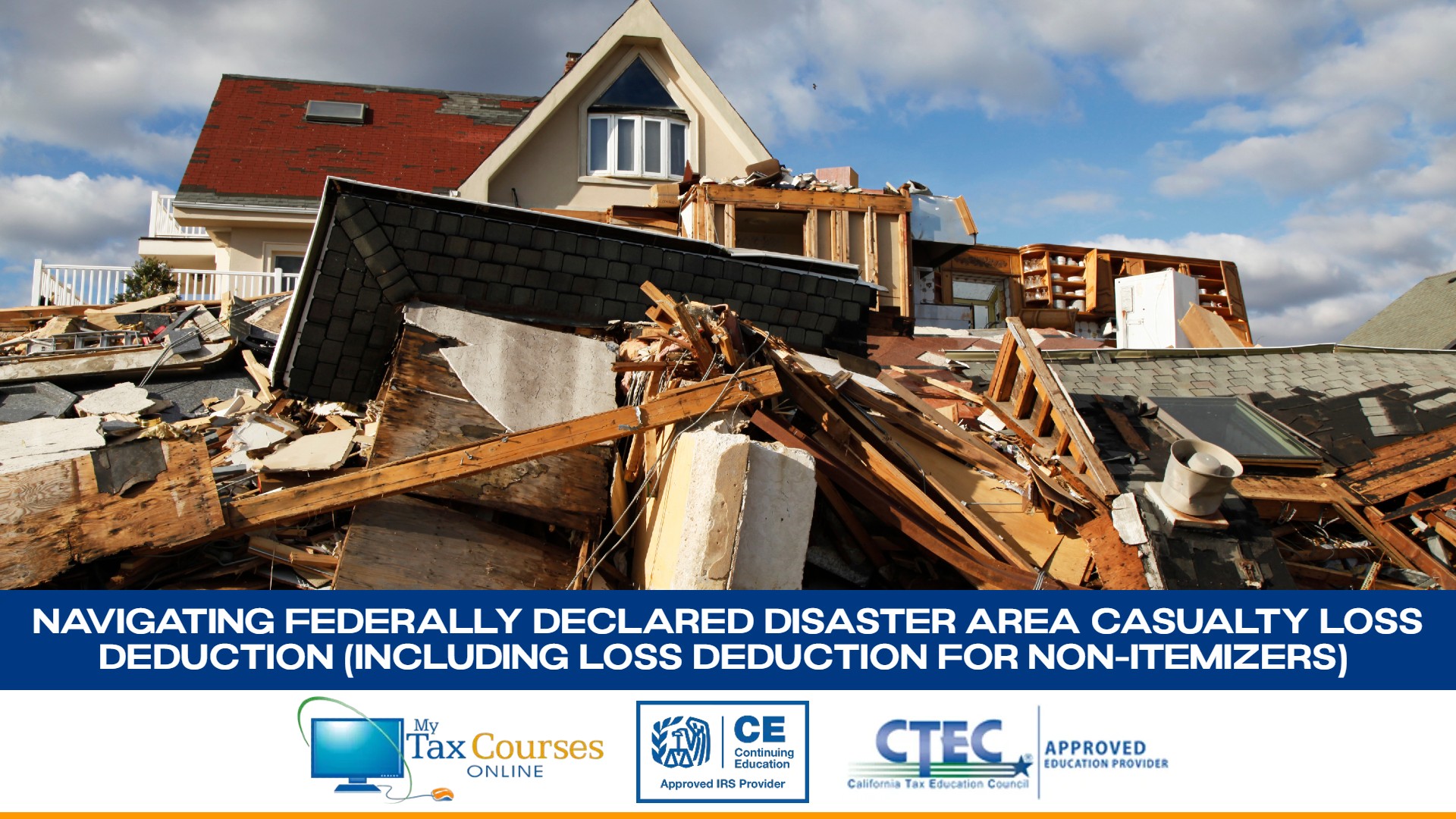When natural disasters strike, they can cause significant property damage and financial loss. For tax preparers, it's essential to understand the tax relief options available to affected individuals, especially the Federally Declared Disaster Area Casualty Loss Deduction. This deduction offers critical relief to taxpayers whose property has been damaged or destroyed by events like hurricanes, floods, fires, and more.
Here, we'll explore how tax preparers can help clients impacted by natural disasters, like the devastating Hurricane Helene, which caused widespread destruction, to claim casualty loss deductions. We'll also highlight how non-itemizers can take advantage of this deduction, providing relief for clients who don't typically itemize their deductions.
Casualty Loss: What It Means for Taxpayers
A casualty loss occurs when a taxpayer's property is damaged, destroyed, or lost due to a sudden, unexpected, or unusual event. Events such as:
- Hurricanes (like Hurricane Helene)
- Floods
- Tornadoes
- Fires
- Earthquakes
Hurricane Helene is a prime example of a natural disaster that led to significant property loss, leaving individuals and families to rebuild after severe flooding, high winds, and storm surges. Casualty losses related to federally declared disasters, such as those caused by Hurricane Helene, may be deductible on a taxpayer's federal income tax return.
Who Can Claim a Casualty Loss Deduction?
To claim a casualty loss deduction, a few conditions must be met:
- The loss must occur in a federally declared disaster area. Following Hurricane Helene, many regions were declared federal disaster areas, enabling impacted residents to qualify for this tax deduction.
- The loss must not be covered by insurance, or the deductible amount must be reduced by any insurance reimbursement or expected reimbursement.
Taxpayers can claim casualty loss deductions for property, household items, or vehicles that were damaged, destroyed, or lost due to disasters like Hurricane Helene.
Special Relief for Non-Itemizers: Casualty Loss Deduction
One of the most helpful aspects of this tax provision is the relief it provides to non-itemizers—those who usually take the standard deduction on their federal tax returns.
In the case of Hurricane Helene or other federally declared disasters, non-itemizers are eligible for an increased standard deduction. This allows more taxpayers, even those who don't typically itemize deductions, to claim relief for property losses.
Here's how the process works for non-itemizers:
- Filing Form 4684: Taxpayers must report their qualified disaster loss using Form 4684 (Casualties and Thefts). For non-itemizers, this is entered on line 15 of the form.
- Increased Standard Deduction: The amount of the loss is added to the standard deduction. This is done by entering the figure on the dotted line next to line 16 on Schedule A as "Net Qualified Disaster Loss." Attach Form 4684 when filing the return.
- Combining Deductions: Non-itemizers combine their regular standard deduction with the casualty loss amount. The combined amount is entered on line 12 of Form 1040 or Form 1040-SR.
Tax Relief for Affected Taxpayers
Taxpayers do not need to be located directly in the disaster zone to qualify for tax relief. In cases like Hurricane Helene, tax preparers whose records or clients are located in affected areas may also be eligible for relief if they are unable to file returns or make payments on time.
For example, suppose a taxpayer's records are in a federally declared disaster zone, or their tax preparer is affected and cannot complete their filing. In that case, the taxpayer may qualify for an extension.
Here's what to do if you or your client is impacted:
- Call the IRS Disaster Hotline: 866-562-5227
- Provide the FEMA disaster number: You can find the FEMA disaster number by visiting https://www.fema.gov/ or contacting FEMA directly.
- Explain that the necessary records are located in a covered disaster area.
Important Details for Tax Preparers
- Documenting Losses: Ensure your clients accurately document all property losses and reduce the claimed amount by any insurance or other reimbursement forms.
- Filing Form 4684: This form is key for reporting disaster-related losses. Make sure it is completed and attached to the tax return.
- Casualty Loss Deductions for Non-Itemizers: Remember that non-itemizers are entitled to claim this deduction, providing relief for a broader range of taxpayers, especially those affected by catastrophic events like Hurricane Helene.
- Extended Filing and Payment Deadlines: Disaster declarations often come with extended deadlines for filing and payments. Be sure to review all relevant IRS notices to determine whether your clients qualify for these extensions.
Learn More with the 2024 Annual Federal Tax Refresher Course
At My Tax Courses Online, we cover important tax topics like these in our 2024 Annual Federal Tax Refresher course. This course offers comprehensive training on current tax laws, regulations, and provisions that tax preparers need to know to serve their clients effectively. Understanding casualty loss deductions, including those for non-itemizers, can make a significant difference in how much financial relief your clients receive after a disaster like Hurricane Helene.
For more information on this topic and other essential updates for tax preparers, click here and check out our 2024 Annual Federal Tax Refresher course at My Tax Courses Online.
Conclusion
Natural disasters can create devastating financial losses, but tax provisions like the Federally Declared Disaster Area Casualty Loss Deduction provide critical relief to those affected. As a tax preparer, you can help your clients maximize their deductions and navigate the complexities of filing for casualty losses, especially after disasters like Hurricane Helene.
For more information on how to file for disaster-related tax relief, visit the IRS's FAQs for Disaster Victims here: https://www.irs.gov/newsroom/tax-relief-in-disaster-situations








